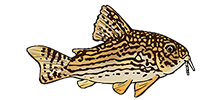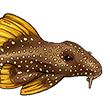Need help identifying a wild-caught catfish
-
Norman Boyd
- Posts: 4
- Joined: 30 Jun 2005, 17:27
- Location 1: Texas, USA
- Contact:
Need help identifying a wild-caught catfish
I fielded a call from a gentleman who described a catfish he had caught and wanted an ID. I have some experience with fish, including aquarium fish, and from his description it sounded like a Cory of some type. He described it as having hard scales, hard body, subterminal mouth, "pointy round nose", and black with yellow verticle bands. It was about 1.5 pounds. He caught it while cast-netting for bait near Victoria, TX in a bayou that connects to the Guadalupe River.
Does this ring a bell with anyone?
Norman Boyd
Port O'Connor, TX
Does this ring a bell with anyone?
Norman Boyd
Port O'Connor, TX
- Silurus
- Posts: 12487
- Joined: 31 Dec 2002, 11:35
- I've donated: $12.00!
- My articles: 55
- My images: 914
- My catfish: 1
- My cats species list: 90 (i:1, k:0)
- Spotted: 438
- Location 1: Singapore
- Location 2: Moderator Emeritus
-
Norman Boyd
- Posts: 4
- Joined: 30 Jun 2005, 17:27
- Location 1: Texas, USA
- Contact:
I had considered that possibility. I think I am familiar with all the local fishes so I eliminated those. The only fish I could come up with (without going to a book store) was a loach. I used to have some yellow and black striped loaches. The hard scales and body made me think of Corys. And, from my experiences, just because a "lay person" neglects to mention a key character doesn't mean it wasn't there. I really didn't know how big Corys got.
- sidguppy
- Posts: 3827
- Joined: 18 Jan 2004, 12:26
- My articles: 1
- My images: 28
- My aquaria list: 5 (i:0)
- Spotted: 9
- Location 1: Southern Netherlands near Belgium
- Location 2: Noord Brabant, Netherlands
- Interests: African catfishes and oddballs, Madagascar cichlids; stoner doom and heavy rock; old school choppers and riding them, fantasy novels, travelling and diving in the tropics and all things nature.
- Contact:
-
Norman Boyd
- Posts: 4
- Joined: 30 Jun 2005, 17:27
- Location 1: Texas, USA
- Contact:
- sidguppy
- Posts: 3827
- Joined: 18 Jan 2004, 12:26
- My articles: 1
- My images: 28
- My aquaria list: 5 (i:0)
- Spotted: 9
- Location 1: Southern Netherlands near Belgium
- Location 2: Noord Brabant, Netherlands
- Interests: African catfishes and oddballs, Madagascar cichlids; stoner doom and heavy rock; old school choppers and riding them, fantasy novels, travelling and diving in the tropics and all things nature.
- Contact:
-
Norman Boyd
- Posts: 4
- Joined: 30 Jun 2005, 17:27
- Location 1: Texas, USA
- Contact:
-
Mike_Noren
- Posts: 1395
- Joined: 25 Jul 2003, 21:40
- I've donated: $30.00!
- My articles: 1
- My images: 37
- My cats species list: 5 (i:0, k:0)
- Spotted: 9
- Location 1: Sweden
- Location 2: Sweden
FWIW, a clown loach (Botia macracanthus) grows to about a foot in length, is a very common aquarium fish, and fits the description.
http://filaman.uni-kiel.de/Photos/Thumb ... m?ID=10897
One thing to ask is if the fish had reddish tail fin and pectoral fins, whereas all other fins should be dark/have black in them.
http://filaman.uni-kiel.de/Photos/Thumb ... m?ID=10897
One thing to ask is if the fish had reddish tail fin and pectoral fins, whereas all other fins should be dark/have black in them.
- DeepFriedIctalurus
- Posts: 236
- Joined: 23 Jan 2003, 04:32
- My cats species list: 11 (i:0, k:0)
- My aquaria list: 1 (i:0)
- Location 2: Saginaw River basin, US
- Interests: anything powered by an internal combustion engine, non-feathered/furred pets, anti-ignorance activism
I'd say it's most likely a or a hybrid between it & . There's no doubt these 2 species aren't kept seperate in Florida fishfarms, and that would explain why so many "common plecos" may not look quite like either species. Anyhow there was a pic of a fish caught in Texas in the cat E-log before under ambrosettii, and that fish could be described as having "black & yellow stripes" if it was a better colored individual. Due to it's uncertain origins & poorly matched patterning, i can understand why it was taken out. That fish may have been one of the possible hybrids I'm referring to.
I found a pic here that might help..
http://cars.er.usgs.gov/pics/db_nonfish0311.jpg
I found a pic here that might help..
http://cars.er.usgs.gov/pics/db_nonfish0311.jpg
- Jools
- Expert
- Posts: 16313
- Joined: 30 Dec 2002, 15:25
- My articles: 198
- My images: 949
- My catfish: 237
- My cats species list: 88 (i:13, k:2)
- My BLogs: 7 (i:10, p:167)
- My Wishlist: 23
- Spotted: 453
- Location 1: Middle Earth,
- Location 2: Scotland
- Interests: All things aquatic, Sci-Fi, photography and travel. Oh, and beer.
- Contact:
Just on the above post and (trying) not to go off topic, I've yet to see any evidence of hybridisation in these fish due to fish farming. I've looked into it twice now and twice we've ended up with a case of mistaken identify. I think it's more to do with the continual non-selective inbreeding of these fish rather than anything else that causes this. We're also not sure of what role P. multiradiatus plays in all this too.
Jools
Jools
Owner, AquaticRepublic.com, PlanetCatfish.com & ZebraPleco.com. Please consider donating towards this site's running costs.
- MatsP
- Posts: 21038
- Joined: 06 Oct 2004, 13:58
- My articles: 4
- My images: 28
- My cats species list: 117 (i:33, k:0)
- My aquaria list: 10 (i:8)
- My BLogs: 4 (i:0, p:164)
- Spotted: 187
- Location 1: North of Cambridge
- Location 2: England.
Going back a bit on the CARS link above, you can search the Guadalupe river, and as a whole, it's got 43 species of (known) non-indigenous speceis.
See here.
Of those are particularly:
Hypostomus sp.
Hypostomus Plecostomus.
However, I'm almost certain that some of these species may well be misidentified species of other Loricardidae genera and species.
Of course, that doesn't at all mean that other non-indigenous (or even indigenous) species aren't available in the area that would match the rough description given above.
1.5 pounds of fish is a pretty decent size, probably about a foot long.
--
Mats
--
Mats
See here.
Of those are particularly:
Hypostomus sp.
Hypostomus Plecostomus.
However, I'm almost certain that some of these species may well be misidentified species of other Loricardidae genera and species.
Of course, that doesn't at all mean that other non-indigenous (or even indigenous) species aren't available in the area that would match the rough description given above.
1.5 pounds of fish is a pretty decent size, probably about a foot long.
--
Mats
--
Mats
-
bronzefry
- Posts: 2198
- Joined: 31 Aug 2004, 16:01
- I've donated: $100.00!
- My articles: 6
- My images: 12
- My cats species list: 17 (i:0, k:0)
- My aquaria list: 7 (i:7)
- Spotted: 6
- Location 1: Sharon, Massachusetts, US
- racoll
- Posts: 5258
- Joined: 26 Jan 2004, 12:18
- My articles: 6
- My images: 181
- My catfish: 2
- My cats species list: 2 (i:2, k:0)
- My aquaria list: 1 (i:0)
- Spotted: 238
- Location 1: London
- Location 2: UK








